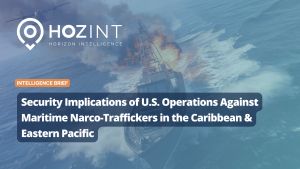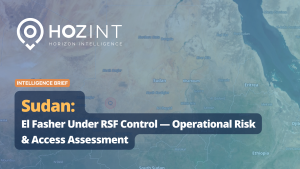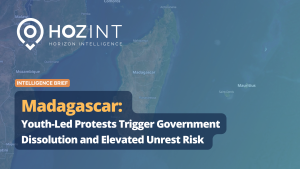Key points
-
August 2025 was one of Colombia’s deadliest months in years, with high-casualty attacks carried out by both the Estado Mayor Central (EMC, FARC dissidents) and the Ejército de Liberación Nacional (ELN).
-
Security forces were the primary targets, but civilians suffered heavily from coercive armed strikes, urban bombings, and crossfire.
-
The EMC demonstrated tactical innovation, particularly in its use of drone-borne explosives in both rural and urban attacks.
-
The ELN relied on ambushes and armed strikes, consolidating its control in Chocó and Catatumbo while pressuring security forces in maritime corridors like Tumaco.
-
In historical terms, August 2025 resembled some of Colombia’s bloodiest months in the early 2000s, though with new technologies and more localized geographic concentration.
What Happened
2 August – Chocó Department (Pacific coast): The ELN declared a 72-hour paro armado (armed strike), forcibly restricting civilian movement. At least six civilians were killed and hundreds displaced. The coercive strike underlined the group’s ability to exercise territorial control over drug-trafficking corridors.
6 August – Cauca Department (Timba): EMC dissidents detonated a roadside improvised explosive device (IED) against an army convoy, killing eight soldiers and two police officers. The group later claimed the attack as retaliation for counter-narcotics raids.
10 August – Norte de Santander (Catatumbo, near Tibú): An ELN unit ambushed a police patrol with grenades and automatic weapons, killing eleven officers. This was among the deadliest ambushes since the collapse of peace talks, part of the ELN’s broader offensive in Catatumbo.
14 August – Valle del Cauca (Jamundí, outskirts of Cali): The EMC launched a drone-borne bombing against a police station. Five police officers were killed and twelve civilians injured. This marked a turning point, with weaponized drones moving from rural skirmishes into urban attacks.
21 August – Cauca Department (El Plateado, Argelia municipality): Heavy fighting between EMC fighters and army troops left at least eighteen dead (ten soldiers and eight guerrillas). Civilians reported homes destroyed in the crossfire, underscoring the blurred line between insurgent warfare and terrorism.
28 August – Nariño Department (Tumaco): ELN guerrillas used improvised mortars to bomb a naval patrol boat, killing seven marines. The strike highlighted Tumaco’s strategic importance as a cocaine departure hub and the ELN’s willingness to challenge the Navy’s control of Pacific trafficking routes.
Analysis
The violence in August 2025 highlights both the continuity of Colombia’s insurgent-terrorist patterns and the emergence of new modalities. The EMC demonstrated its capacity to conduct coordinated, high-casualty operations across multiple theaters. Its adoption of drones to bomb a police station near Cali on 14 August reflected a significant technological shift: whereas FARC insurgents in the 1990s and 2000s relied on crude car bombs, EMC dissidents are now fielding precision drone attacks, allowing them to strike hardened targets inside urban areas.
The ELN, by contrast, leaned on traditional insurgent tactics—ambushes, armed strikes, and mortar fire. Its 10 August ambush in Catatumbo, which killed eleven officers, was a grim echo of the ambushes that dominated headlines in the early 2000s. Meanwhile, its paro armado in Chocó and its naval attack in Tumaco revealed the ELN’s dual strategy of coercing local populations while contesting control over trafficking routes.
Geographically, violence was concentrated in two belts: the southwest (Cauca, Valle del Cauca, Nariño) and the northeast (Catatumbo, Norte de Santander). This marks a shift from the nationwide insurgent campaigns of the early 2000s, when the FARC projected power across almost the entire country. Bogotá, Medellín, and other major urban centers remain relatively insulated, though the Jamundí drone bombing shows Cali is becoming a critical urban battleground.
Civilians were not the primary targets in August, but they remained highly vulnerable. In Chocó, the ELN’s restrictions directly killed civilians and paralyzed daily life. In Jamundí, civilians were wounded in an urban bombing. In Cauca, they were caught in the crossfire of pitched battles. This mirrors Colombia’s insurgent past, where the line between insurgent warfare and terrorism was always blurred.
Strategically, the escalation is a direct consequence of the collapse of President Petro’s “Total Peace” initiative. With ceasefires dissolved, both the EMC and ELN have reverted to maximalist violence to assert territorial dominance and pressure the state. Every government security operation risks prompting further ambushes, kidnappings, or bombings.
August 2025 ranks among the bloodiest months since the early 2000s. During that earlier period, FARC and ELN ambushes often killed dozens of soldiers in Caquetá, Putumayo, and Arauca. The Amalfi helicopter shoot-down on 21 August 2025 that killed thirteen officers is one of the most lethal single incidents against Colombian security forces since the mid-2000s. The Jamundí drone bombing is a modern analogue of the 2019 ELN Bogotá police academy bombing, but with new technology and a wider civilian impact.
Compared to the post-2016 FARC peace process era, when nationwide violence dropped sharply, August 2025 represents a reversion to large-scale, coordinated insurgent-terrorist attacks. Yet unlike the 1990s–2000s, the violence today is geographically constrained—focused on southwest and northeast drug corridors rather than the entire national territory.
The technological shift is perhaps the most striking. In the past, insurgents relied on car bombs, landmines, and mortars. Today, drones are emerging as a disruptive weapon, capable of targeting police stations, military bases, and even helicopters in flight. This puts Colombia’s insurgent violence at the cutting edge of asymmetric warfare, aligning it with global trends in Ukraine, the Middle East, and Myanmar.
In sum, August 2025 sits at the intersection of Colombia’s insurgent past and its asymmetric future: a month that echoed the mass-casualty ambushes of the early 2000s while introducing drone warfare into the country’s urban security equation. Unless the government re-establishes credible negotiations or mounts a decisive counterinsurgency campaign, Colombia is poised to endure a new cycle of violence—one that blends familiar insurgent brutality with modern terrorist innovation.
Forecast (Sep–Dec 2025 and into early 2026)
Through the remainder of 2025, Colombia’s terrorism picture will be driven by two overlapping campaigns: EMC dissidents pressing the southwest (Cauca–Valle del Cauca–Nariño) and the ELN consolidating terrain in the northeast (Catatumbo) while keeping pressure on Pacific maritime corridors. Both groups will target the state more than civilians, but bystander harm will remain significant in urban peripheries and transit nodes.
In the southwest, EMC fronts are likely to sustain a high operational tempo built around roadside IEDs, ambushes of army and police patrols, and opportunistic strikes on fixed sites (police stations, rural army posts, road tolls). The August use of weaponized drones is unlikely to have been a one-off: expect more quadcopter-delivered munitions against static targets and, occasionally, low-flying rotary assets on coca-eradication or troop-lift missions. The geography of risk will hew closely to the Buenaventura–Cali–Jamundí–Cauca axis, where coca logistics, cash, and corridors converge. Inside major cities, the EMC will probably avoid mass-casualty tactics that would trigger overwhelming political and military backlash; nevertheless, small bombs near police infrastructure, convoy timings on approach roads, and outer-ring substations or checkpoints remain credible targets. Civilian exposure will be highest where those installations sit within or alongside dense neighborhoods and market streets.
In Catatumbo, the ELN’s incentives favor continued ambushes and IED harassment of police and army patrols, interspersed with short “armed strikes” (paros armados) to freeze civilian mobility and signal social control. The group’s current battlefield logic—competing with rivals for coca fields and cross-border flows—creates persistent pressure on the Cúcuta periphery and rural Tibú–El Tarra belts. In parallel, the ELN will look to the Pacific to contest state interdiction: improvised mortars and standoff fire against navy and riverine units around Tumaco are likely to recur, calibrated to disrupt patrol patterns rather than hold ground. Urban ELN activity will remain mostly intimidatory (night shots at police posts, crude devices at tolls or roadside cabins) with a continued stated preference to limit civilian deaths in cities; the risk to bystanders nonetheless stays material around outer-urban police assets.
Bogotá and Medellín should remain comparatively insulated. The probability of a large, spectacular attack in either city is low; the more realistic urban risk profile is a sporadic, small explosive targeting police with collateral injuries to passers-by. Cúcuta and Cali sit in a higher tier: not front-line city centers per se, but close enough to conflict corridors that small-to-moderate incidents can spill into their outskirts and feeder roads.
Three dynamics will shape the curve of violence. First, state operations: every surge—eradication drives, high-value target raids, or “stabilization” pushes—tends to produce short, sharp spikes in reprisals (IEDs, ambushes, harassment fire). Second, fragmentation and discipline inside EMC and ELN: local commanders control tempo; splinters can escalate beyond national leadership intent, raising the chance of urban miscalculation. Third, cross-border sanctuary and financing: continued freedom of movement on the Venezuelan side of Catatumbo and buoyant cocaine rents will underwrite both groups’ capacity to absorb losses and innovate tactically (notably with drones and better fusing for roadside devices).
Baseline expectation for Sep–Dec 2025 is sustained high-intensity rural conflict in Cauca–Valle–Nariño and Catatumbo (high likelihood), occasional urban-peripheral attacks around Cali and Cúcuta (medium-high), and sporadic, low-yield incidents in other cities (medium-low). Civilian coercion in the form of short-notice road closures, forced “civic” blockades, and displacement events is likely to recur where the groups seek leverage or passage guarantees. Looking into early 2026, absent a credible, verifiable ceasefire with enforceable local command buy-in, the most probable trajectory is a grinding war of attrition: steady security-force casualties, episodic high-fatality days when ambushes or standoff fires land, and gradual diffusion of drone-enabled precision strikes from rural to peri-urban environments.
Operationally, this translates into: heightened risk to ground movements on rural primaries and secondary roads in the southwest and Catatumbo; periodic interdictions and intimidation around Pacific and riverine chokepoints; and a need for counter-UAS hardening at police/military sites within 30–50 km of active fronts. The window for material improvement before mid-2026 is narrow and would require both a tempered state posture (to avoid tit-for-tat escalation triggers) and faction-specific pacts that actually bind local commanders—conditions that, for now, are only partially in place.



